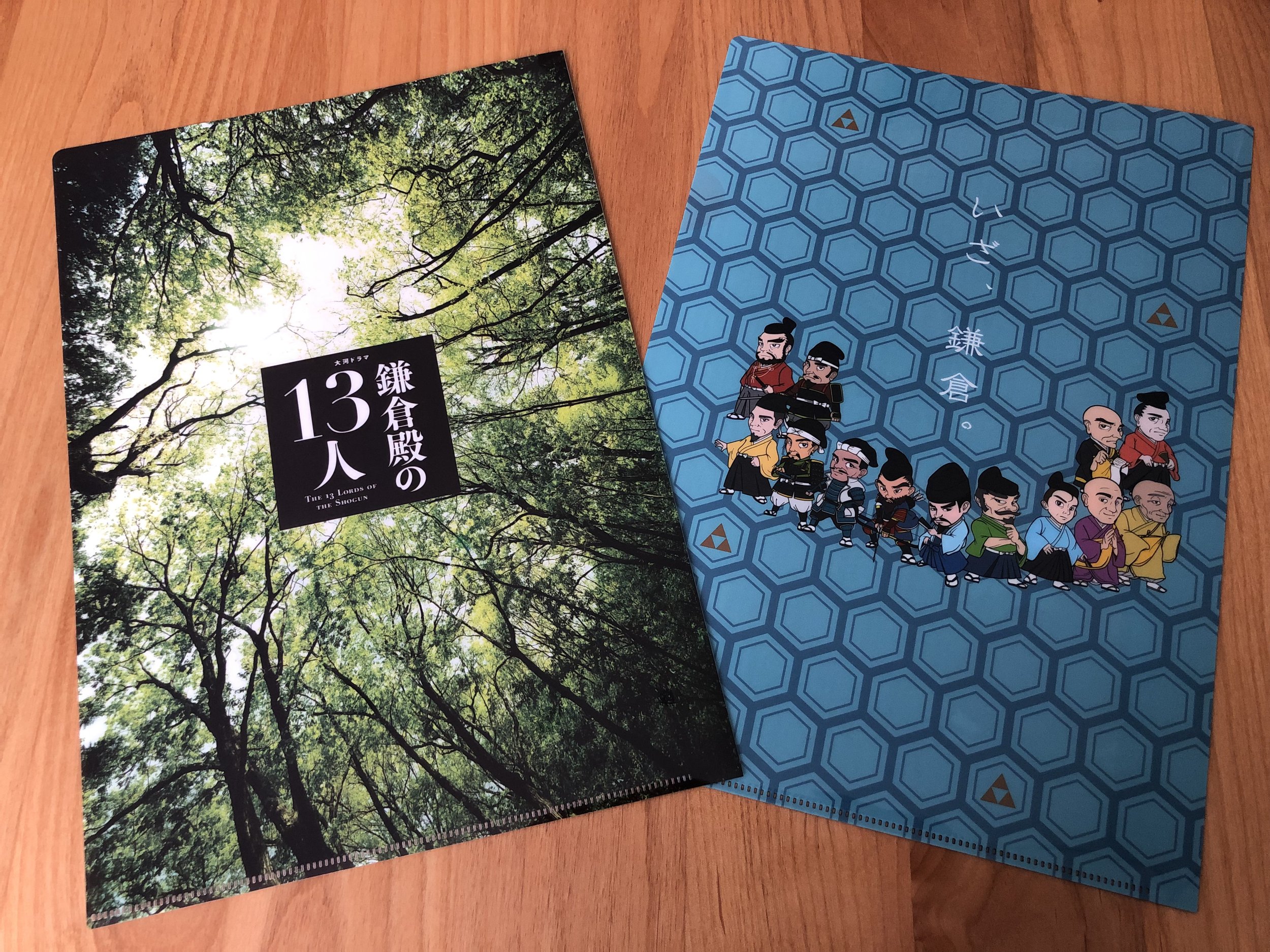March 1, 2022 marked the opening of a different kind of exhibition in Kamakura: one dedicated to a Japanese period TV series called “The 13 Lords of the Shogun” (“The 13 Lords”), which premiered in January 2022 and will run for the entire year on Sunday evenings from 8:00 pm.
Courtesy of Taiga Drama Kan
This is not the first time for such an exhibition to open in Japan. In fact, from the beginning of the 21st century, exhibitions entirely based on “taiga” television series have been held all across Japan, their locations coinciding with the regions highlighted in the respective TV pieces.
To my amazement, I learned during my visit that a similar but smaller exhibition is also on display in the Izu peninsula, about 50 miles southwest of Kamakura, an area where the Hojo clan has roots.
THE TV SERIES
In 2022, the taiga TV series, or taiga dramas (大河ドラマ) as they are also known, reached the beautiful age of 61, living up to their “large river” name. These long-running, large-scale historical sagas air during Japan’s “Golden Time” broadcast programming block, allowing viewers to end the week in style. A large majority of the 61 taiga TV series produced to date are period pieces, serving as proof of how much Japanese enjoy refresher history lessons mixed with entertainment. And the entertainment factor is exceptionally high, since the taiga TV series always features the most popular actors of the year alongside veteran stars.
“The 13 Lords” is no exception to the taiga template. Currently, “The 13 Lords” features more than 15 well-established Japanese actors, and much to the the excitement of the show’s fans, actors are being added as the story evolves and characters develops.
An interesting boost to this year’s taiga series has come in the form of the inclusion of two famous representatives from Japan’s comedy world.
One is Mr. Koki Mitani, arguably the nation’s most well-known dramatist, who brings his signature element of the unexpected to the “The 13 Lords” screenplay. You may know Mitani as the creator of movies such as “Suite Dreams” or “Magic Hour”.
The other notable representative from Japanese comedy involved in “The 13 Lords” is Mr. Yo Oizumi, whose performances weave together comedic and heartwarming moments. While most of Oizumi’s movies are for domestic distribution, “Restaurant in the Sky” is one of his recent works promoted at US film festivals.
“The 13 Lords” goes back about 800 years to a time marked by a change in leadership, with power shifting from the Imperial Court to the military government of the Shogun from the western capital of Kyoto to the eastern one of Kamakura, which is just about 40 miles south of Tokyo. Thus, while the main historical events depicted are important and well-known, the creators of the series chose to focus on the lesser-known Hojo clan, which controlled the Shogun’s advisory council and officially served as a regent of the shogunate.
Taiso Yoshitoshi. Minamoto Yoritomo on Horseback Attacking an Enemy, 1886.
Specifically, the series centers on the clan’s third-born, Yoshitoki Hojo, the only regent lord out of the initial 13 who survives the political power games. (FUN FACT: Mr. Mitani, the series playwright, joked at a press conference for ”The 13 Lords” that Yohitoki Hojo’s in-spite-of-all-odds story resembles the story told in Mario Puzo’s “The Godfather”). Yoshitoki’s successful yet lonely journey is embodied for the series by the charismatic Mr. Shun Oguri, who stars in several series available on Netflix, the most recent being “Japan Sinks”.
Overall, the ”The 13 Lords” story is one of negotiations and battles, of alliances and betrayals, of both brotherly and romantic love, and with the 13th episode airing on the first Sunday in April, it promises to keep the audience wanting more.
THE EXHIBITION
Courtesy of Olivia S.
It was quite hard to believe the museum building is 65 years old! Besides being extremely well-kept, its modern, simple look is the product of Mr. Junzo Sakakura’s designs, an apprentice of the grand French architect Le Corbusier.
Courtesy of Olivia S.
“The 13 Lords” exhibition is hosted by the Tsurugaoka Museum, on the premises of the 800-year-old Tsurugaoka Hachimangu, the largest and most well-known Shinto shrine in Kamakura city, which was Japan’s capital for almost 150 years.
Why here? It’s definitely not a coincidence that the historical figure who had the shrine built is one of the main characters of the TV series, Minamoto no Yoritomo - the founder and first Shogun of the Kamakura shogunate.
Courtesy of Taiga Drama Kan
The entire site is in harmony with the natural environment, incorporating Japanese architectural elements and construction materials, creating a truly unique and peaceful atmosphere.
The “The 13 Lords” exhibition fills an entire floor with displays that offer something for everyone!
Four screen displays allow visitors to access the stories of the central characters through no-touch hand movements from a designated place in front of the displays. This truly made me feel that the futuristic world of “Minority Report” has become reality, only 20 years after we considered it pure science fiction.
Courtesy of Taiga Drama Kan
An extensive and colorful display of costumes actually worn by the main characters is made even more valuable in fans’ eyes by the makeup stains visible in places. Standing right next to the costumes are life-size cardboard cutouts of some of the main characters, which make for some great selfies!
Courtesy of Olivia S.
Courtesy of Olivia S.
A spacious photo booth with an exquisite golden folding screen in the background, recreates the feeling of a traditional tatami mansion room, similar to the ones most indoor scenes are filmed in for the series. Moreover, traditional hats, similar to the ones worn by the series’ male characters to signify noble background, are also available to help visitors transform into the characters they watch every week;
Courtesy of Olivia S.
Courtesy of Olivia S.
A screening area equipped with about 20 chairs offers two behind-the-scenes videos, with narration by a historian that emphasizes the research that went into recreating the events of the day. This is probably the most popular part of the exhibition, allowing fans to catch their breath after enjoying the previous exhibit areas, all while learning unique facts.
From the dark screening area, the exhibit continues outdoors with a large panel clarifying the characters’ intricate relationships and the historic timeline - an amazing family tree of “The 13 Lords”, which draws visitors in for careful examination.
Courtesy of Olivia S.
The last stop on the exhibition floor is a display of shikishi boards bearing the signatures the most famous performers in the series. They also contain short messages written in the stars’ handwriting, providing yet another way to feel closer to the world created on screen. Empty spaces around the shikishi boards stand out, encouraging fans to let their imagination explore who else may become part of “The 13 Lords” world.
A visit to the exhibition would not be complete without a stop at the souvenir shop! Since we are in Japan where culinary souvenirs are held in such high regard, one can find an extensive selection of sweets and snacks, beautifully wrapped or boxed. But one can also find souvenirs from the series that last longer: T-shirts, caps, towels, totes, lots of stationery and much more!
Courtesy of Olivia S.
Courtesy of Olivia S.
Courtesy of Olivia S.
Courtesy of Olivia S.
Personally, I had to add “The 13 Lords” to my “clear file” collection. These lovely plastic folders not only help you organize paperwork but also remind you of places you visited.
Courtesy of Olivia S.
After so much excitement, fans must feel content and ready to head back home… and still one more exciting attraction is available. A special portrait poster that moves and talks!
You only need a smartphone to access the dedicated website and then capture the exhibition poster with your phone camera - you can then hear and see the poster’s protagonist and PR rep, Hojo-san, inviting you to visit the exhibition, while using old Japanese narration and changing facial expressions to make it all more fun. The AR poster is a product of a local Kamakura IT design company and can be found in 350 places across the city, such as train stations, bus terminals and shopping arcades. The poster can also be experienced on this website (Japanese only).
Courtesy of Taiga Drama “Kamakura Dono no 13 Nin”
Even after 15 years of living in Japan, I continue to be amazed by Japan’s inventivity that continues to generate new attractions. A period TV series running for a whole year can become the theme of a 10.5-month exhibition - because, through a well-balanced combination of traditional display and hi-tech elements, it brings the world of the TV screen closer to its fans. It seems it might be possible the series’ stars may actually visit the exhibition and, if announced in advance, that would be a total success!

















